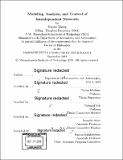Modeling, analysis, and control of interdependent networks
Author(s)
Zhang, Jianan, Ph. D. Massachusetts Institute of Technology
DownloadFull printable version (20.18Mb)
Other Contributors
Massachusetts Institute of Technology. Department of Aeronautics and Astronautics.
Advisor
Eytan Modiano.
Terms of use
Metadata
Show full item recordAbstract
The integrations of communication and physical networks facilitate network monitoring, operation and control, advancing the development of Internet of Things, smart power grids, and other cyber-physical systems. In these integrated networks, one network depends on another in order to be fully functional, leading to interdependence. The interdependence brings new challenges in the evaluation of network robustness under failures, and the design of control policies for mitigating failures, since failures may cascade from one network to another network that depends on it. We develop new models and analytical tools to study interdependent networks, with a focus on designing robust interdependent networks that can withstand failures and attacks. We first model two interdependent networks of arbitrary topologies by layered graphs, where nodes in the demand layer depend on nodes in the supply layer. We study the supply node connectivity of the demand layer network: namely, the minimum number of supply node removals that would disconnect the demand network. We develop algorithms to evaluate the supply node connectivity given arbitrary network topologies and dependence between networks. We develop dependence assignment algorithms that maximize the supply node connectivity to enhance network robustness. We then study the robust routing problems: namely, delivering information or commodities through paths with high reliability. We develop algorithms to compute the path failure probability under correlated failures, and obtain the most reliable path for single-path routing and most reliable pair of paths for diverse routing between any pair of nodes in a network. To study the formation and properties of large-scale interdependent networks, we develop an interdependent random geometric graph (RGG) model. The model represents two interdependent spatially embedded networks where interdependence exists between geographically nearby nodes in the two networks. We characterize the emergence of the giant mutual component in two interdependent RGGs as node densities increase, and obtain analytical bounds and confidence intervals for the percolation thresholds. This new model and analytical tools provide a framework for robustness evaluation of large-scale interdependent networks under uniform random node failures, geographical attacks, and degree-dependent failures that capture non-uniform vulnerabilities of network components. Finally, we consider two applications of interdependent networks. First, we consider interdependent power grid and communication network. We characterize the impact of communication failures on power grid control, and develop control policies for power grid frequency regulation and economic dispatch using limited communication. Second, we consider the robustness of distributed computing networks, where network flows depend on both communication and computation resources. We study the network robustness under the failure of network resources and solve network flow interdiction problems.
Description
Thesis: Ph. D., Massachusetts Institute of Technology, Department of Aeronautics and Astronautics, 2018. Cataloged from PDF version of thesis. Includes bibliographical references (pages 221-229).
Date issued
2018Department
Massachusetts Institute of Technology. Department of Aeronautics and AstronauticsPublisher
Massachusetts Institute of Technology
Keywords
Aeronautics and Astronautics.